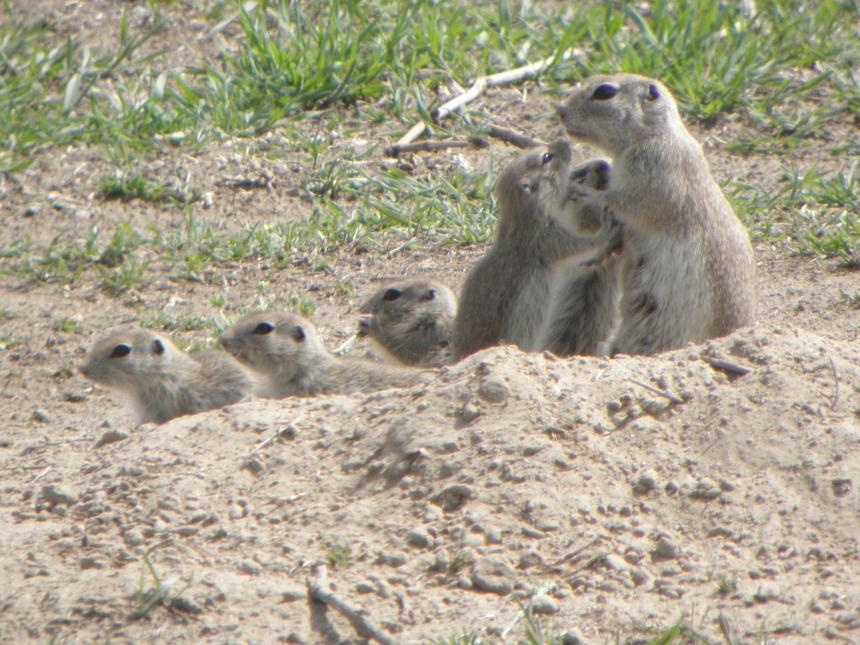Moderate-
High
The population size and trend of Townsend's ground squirrel in Washington is unknown. Population status of this Washington-endemic ground squirrel requires clarification. Significant declines have occurred in many areas, yet this species is common at a number of human-modified locations. Note: there are two subspecies of Townsend's ground squirrel: populations occurring south and west of the Yakima River are Urocitellus townsendii townsendii (a state candidate); Urocitellus townsendii nancyae occurs north and east of the Yakima River and is not designated as a state candidate.
Description and Range
Ecology and life history
Townsend’s ground squirrels are a burrowing species found primarily in small to fairly large colonies, but they also occur solitarily.
The squirrels historically occurred primarily in native shrubsteppe, grasslands, and large patches of sagebrush at the lower edges of forest. A variety of human-modified habitats are now also occupied, including pastures, abandoned fields, orchards, vineyards, hop fields, canal banks, and sites adjacent to irrigated fields and springs. Occupied sites must have ample soil depths to provide space for burrow construction.
The squirrels are active for only four to five months, spending the rest of the year hibernating. Adults emerge from hibernation from January to February and mate soon after. Litters average about eight pups and first appear above ground in March to April.
Adults and juveniles consume large amounts of food before hibernation in an effort to gain adequate fat reserves to survive through hibernation. Animals enter hibernation in May and June.
Burrows provide safety from predators, shelter from bad weather, protection for raising young, and a stable environment for hibernation.
Diet is broad and comprised mainly of grasses, forbs, and seeds.
American badgers, raptors, and snakes are the most important predators.
Geographic range
Townsend's ground squirrels are found only in Washington in the Columbia Basin west of the Columbia River in Klickitat, Benton, Yakima, and Kittitas counties.
Although total population size and trend are unknown, the species has greatly declined or become extirpated in many areas. However, it remains relatively common at some sites, including human-altered locations.
Climate vulnerability
Sensitivity to climate change
Moderate-
High
Sensitivity of Townsend's ground squirrel is likely driven by their association with shrub-steppe and grassland habitats (although they are able to inhabit a number of habitat subtypes which may decrease sensitivity). Warmer temperatures and changes in precipitation, including drought, could alter the quality and availability of important food plants, affecting the species' ability to accumulate adequate fat reserves before hibernation. Similar species (e.g., Piute ground squirrel, U. mollis) are known to decline during periods of drought. Warmer, drier conditions that lead to more frequent and hotter fires and/or encourage the growth of invasive weeds (e.g., cheatgrass) may degrade or alter natural habitat for Townsend's ground squirrels.
Exposure to climate change
Moderate
- Increased temperatures
- Changes in precipitation
- Drought
- Altered fire regimes
- Increased invasive species
Conservation
Conservation Threats and Actions Needed
- Resource information collection needs
- Threat: Adequate data on the species abundance, trend, and threats are lacking.
- Action Needed: Undertake comprehensive field surveys to determine abundance, habitat use, and threats.
- Fish and wildlife habitat loss or degradation
- Threat: Habitat loss and fragmentation due to agriculture and other development. Habitat fragmentation may isolate remaining populations.
- Action Needed: Use landowner incentives, agreements and conservation easements to protect significant colonies. Conduct translocations to establish new populations in suitable habitat.
- Invasive and other problematic species
- Threat: Invasion of shrubsteppe by cheatgrass and other non-native plants has degraded habitats.
- Action Needed: Restore and manage degraded habitat at colonies and sites chosen for translocations.
- Overharvesting of biological resources
- Threat: Some level of shooting and other forms of control continues despite partial legal protection.
- Action Needed: Perform analysis to determine if this species warrants classification as protected wildlife. Conduct education and outreach to landowners and recreationists.
See the Climate vulnerability section for information about the threats posed by climate change to this species.
Our Conservation Efforts
Research and monitoring
Little research and few conservation actions aimed specifically at Townsend's ground squirrels have been undertaken. WDFW maintains a database of known sites for the species, which is updated as new reports are received.
Land acquisitions
A WDFW land acquisition east of Ellensburg in 2006 and 2007 permanently protected about 17,500 acres of shrub-steppe, including some habitat for Townsend's ground squirrels.
Landscape management
The Washington Wildlife Habitat Connectivity Working Group is addressing the conservation and restoration of habitat connectivity for numerous focal species, including Townsend's ground squirrels. A statewide connectivity analysis was completed in 2010 (WHCWG 2010) (PDF) and a regional analysis for the Columbia Basin is currently being conducted and should be completed by 2012. The latter analysis is modeling habitat concentration areas and movement corridors for Townsend's ground squirrels.
The Arid Lands Initiative is a group of governmental (WDFW, Washington Department of Natural Resources, Bureau of Land Management) and non-governmental organizations (The Nature Conservancy) formed in 2010 to engage landowners with the goal of conserving shrubsteppe across multiple jurisdictions. Townsend's ground squirrels have been identified as one of the focal species for which conservation strategies will be developed and implemented.
Partners and Cooperators:
- U.S. Fish and Wildlife Service
- The Nature Conservancy
- Washington Department of Natural Resources
Resources
References
Sato, C.L. 2012. Habitat connectivity for Townsend’s ground squirrel (Urocitellus townsendii) in the Columbia Plateau Ecoregion.
Washington Department of Fish and Wildlife, Olympia, Washington. Washington Department of Fish and Wildlife (WDFW). 2013. Threatened and endangered wildlife in Washington: 2012 annual report. Washington Department of Fish and Wildlife, Olympia, Washington.
